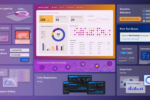It’s like driving in a fog without data visibility. When you can’t see exactly where your data is and how it’s moving, your decisions become uncertain, and your business becomes vulnerable. Fortunately, the technologies are now available to give you real-time, complete visibility and a real competitive advantage.
What is data visibility?
Data visibility is the ability to find, access, monitor, and understand your data – everywhere it lives. Without it, you can’t detect threats early, trust your dashboards, prove compliance, make fast, confident decisions.
Why is it important?
Critical data security: Enterprises are high-value targets for cyber terrorists and hackers. Without visibility into where sensitive data resides, who accesses it, and how it moves, threat detection becomes reactive instead of proactive, leaving you open to threats.
Data-driven decision-making: The more data sources an organization creates, the greater the risk of inaccurate data. Imagine relying on inaccurate data to make decisions that affect millions of people – it can lead to costly mistakes and missed opportunities.
Complexity and costs: In the quest for “more data,” modern stacks can span multiple services, SaaS applications, and analytics platforms. This increases the risk of duplicate, outdated, or siloed data and unnecessarily inflated costs.
Regulatory compliance: Today’s regulators demand clear data inventories, audit trails, and breach reporting within strict timelines. A single misstep can result in hefty fines and reputational damage.
Struggles with data visibility
Fragmented data across complex systems
As technology companies scale, they often adopt a mix of on-premises servers, cloud services, SaaS applications, and other solutions. Without a centralized data monitoring solution, data becomes fragmented across multiple environments, making it difficult to track. This fragmentation often leads to missing insights and hidden risks-critical elements that can derail strategic decisions.
Lack of real-time insights and monitoring
Data moves quickly in dynamic technology environments, especially in DevOps and cloud-native setups. However, many organizations lack real-time visibility into how data is flowing across systems and who is accessing it. This lag leaves you exposed to threats (like data breaches) and delays your ability to act quickly when problems arise.
Lack of reliable data governance
Without a robust data governance framework, organizations lack consistent policies for data access, classification, retention, and protection. These policies may be inconsistently applied across departments or may not be aligned with the organization’s overall security or compliance strategy. Inconsistent governance not only puts data at risk but also creates operational chaos.
Lack of accurate data reporting
Companies struggle when trying to break down data and gain insights. A lack of integration between data sources produces inconsistent results, and manually collecting, refining, or analyzing the results becomes time-consuming and error-prone. Not only does this cause delays, but it also creates inconsistencies in results across departments-leading to wasted resources and missed opportunities for optimization.
How can companies ensure data visibility across departments?
Data consolidation
By ensuring that all data streams are unified into a single source of truth (SSOT), you can minimize the risk of working with copied or inaccurate data.
For example, Strategy’s AI+BI platform, Strategy One, has a semantic layer that organizes and connects data across the enterprise, ensuring consistent rules, definitions, and metrics. As a result, your teams can access the most refined, accurate, and timely data across departments for a competitive advantage.
AI
Leaders deliver innovative insights, in-depth dashboards, and ad hoc analysis to their customers by leveraging AI-powered solutions as the backbone of data analytics. By integrating AI into business intelligence, you can uncover deep insights, create sophisticated dashboards, and gain a better understanding of your customers’ needs.
Cloud
Migrating to a cloud-native business intelligence platform offers several security-related benefits.
For example, Strategy One leverages a cloud-based, multi-tenant architecture that allows users to connect to major hyperscalers such as Amazon Web Services (AWS), Microsoft Azure, or Google Cloud Platform. Strategy One then leverages each hyperscaler’s security features and protocols to create a layered, foolproof defense strategy for your technology enterprise. Your data is not only secure but also fortified by industry-leading cloud defenses.
BI
Who says data analysis has to take hours? By integrating GenAI and machine learning into your business intelligence, you can apply natural language queries to perform complex tasks and receive actionable insights in seconds. Imagine asking a question and getting the answer in real time.
Strategy One gives you the power to make decisions on the fly, without waiting for reports.
Summary
Complete data visibility is achievable with the right mix of attitude and innovation, and modern AI+BI solutions like Strategy One are just around the corner, ready to help you transform your business.
Don’t let blind spots slow your growth. It’s not just about seeing more, it’s about seeing smarter.


